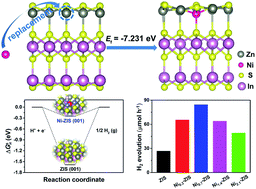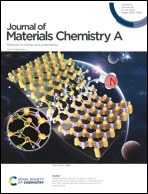Inert basal plane activation of two-dimensional ZnIn2S4via Ni atom doping for enhanced co-catalyst free photocatalytic hydrogen evolution†
Abstract
Designing photocatalysts with appropriate intrinsic active sites for the hydrogen evolution reaction (HER) and efficient charge-carrier separation is critical to get rid of the dependence on co-catalysts. Herein, we for the first time trigger the catalytic activity of inert basal plane S atoms in two-dimensional hexagonal ZnIn2S4 (ZIS) via Ni atom doping (Ni-ZIS). Density functional theory calculations (DFT) and X-ray absorption fine structure (XAFS) investigations reveal that Ni atoms preferably replace Zn atoms in ZIS. And introducing Ni atoms would form new hybridized states near the Fermi level and modulate the electronic properties of their neighboring S atoms, leading to optimized hydrogen adsorption free energy and enhanced HER kinetics. Additionally, fs-transient absorption spectroscopy measurements illustrate a prolonged recovery lifetime of photoexcited electrons in Ni-ZIS. Consequently, Ni-ZIS exhibits an improved photocatalytic activity with a hydrogen evolution rate of 4220 μmol g−1 h−1 under visible light irradiation (λ > 420 nm) without any co-catalysts, roughly 3.2 times higher than that of ZIS. The apparent quantum efficiency at 380 and 420 nm could reach as high as 19.7% and 17.1%, respectively. This single atom modulation strategy presents a facile and promising pathway to enhance the photocatalytic activity of ZIS for the HER without co-catalysts.



 Please wait while we load your content...
Please wait while we load your content...